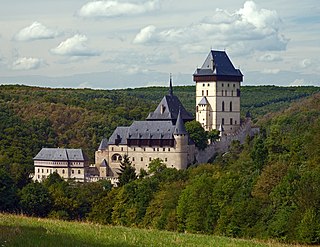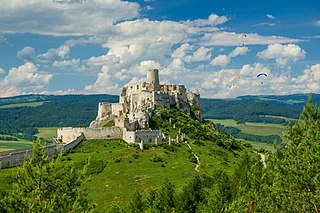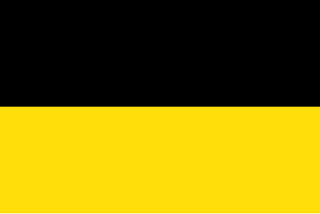External links
Slavic-language terms for administrative divisions | |
|---|---|
| Current | |
| Historical | |
| Authority control databases: National |
|---|
| | This article about geography terminology is a stub. You can help Wikipedia by expanding it. |
Okres (Czech and Slovak term meaning "district" in English; from German Kreis - circle (or perimeter)) refers to administrative entities in the Czech Republic and Slovakia. It is similar to Landkreis in Germany or "okrug" in other Slavic-speaking countries.
The first districts in the Czech lands developed from domains in 1850 by the decision of the Imperial government of Austria. In the territory of present-day Slovakia their predecessors were districts of the counties of the Kingdom of Hungary (slúžnovský okres in Slovak). The organisation and functions of the districts were different in the Czech lands and Hungary. After the creation of Czechoslovakia districts became an administrative unit of the new state with a unified status. After the dissolution of Czechoslovakia in 1993, the district system was taken over by the two current successor states.

Bohemia is the westernmost and largest historical region of the Czech Republic. Bohemia can also refer to a wider area consisting of the historical Lands of the Bohemian Crown ruled by the Bohemian kings, including Moravia and Czech Silesia, in which case the smaller region is referred to as Bohemia proper as a means of distinction.

Czechoslovakia was a landlocked state in Central Europe, created in 1918, when it declared its independence from Austria-Hungary. In 1938, after the Munich Agreement, the Sudetenland became part of Nazi Germany, while the country lost further territories to Hungary and Poland. Between 1939 and 1945, the state ceased to exist, as Slovakia proclaimed its independence and Carpathian Ruthenia became part of Hungary, while the German Protectorate of Bohemia and Moravia was proclaimed in the remainder of the Czech Lands. In 1939, after the outbreak of World War II, former Czechoslovak President Edvard Beneš formed a government-in-exile and sought recognition from the Allies.

The Sudetenland is the historical German name for the northern, southern, and western areas of former Czechoslovakia which were inhabited primarily by Sudeten Germans. These German speakers had predominated in the border districts of Bohemia, Moravia, and Czech Silesia since the Middle Ages. Since the 9th century the Sudetenland had been an integral part of the Czech state both geographically and politically.
Kreis is the German word for circle.

Spiš is a region in north-eastern Slovakia, with a very small area in south-eastern Poland. Spiš is an informal designation of the territory, but it is also the name of one of the 21 official tourism regions of Slovakia. The region is not an administrative division in its own right, but between the late 11th century and 1920 it was an administrative county of the Kingdom of Hungary.

Regions of the Czech Republic are higher-level territorial self-governing units of the Czech Republic.

Since 1949, Slovakia has been divided into a number of kraje. Their number, borders and functions have been changed several times. There are eight regions of Slovakia and they correspond to the EU's NUTS 3 level of local administrative units. Each kraj consists of okresy. There are 79 districts.

The South Banat District is one of seven administrative districts of the autonomous province of Vojvodina, Serbia. The administrative center of the district is the city of Pančevo. The district lies in the region of Banat. According to the 2011 census results, it has a population of 260,244 inhabitants.

The Trnava Region is one of the eight Slovak administrative regions. It was established in 1996, before which date, most of its districts were parts of Bratislava Region which was established on the founding of Czechoslovakia in 1923. It consists of 251 municipalities, from which 16 have a town status. It is the second most densely populated region in Slovakia.

The Kingdom of Bohemia, sometimes referenced in English literature as the Czech Kingdom, was a medieval and early modern monarchy in Central Europe. It was the predecessor state of the modern Czech Republic.
A Kraj is the highest-level administrative unit in the Czech Republic and the Slovak Republic. For lack of other English expressions, the Slavic term is often translated as "province", "region", or "territory", although it approximately means "(part of) country", or "(part of) countryside". A kraj is subdivided into okresy ("districts").

Austrian Silesia, officially the Duchy of Upper and Lower Silesia, was an autonomous region of the Kingdom of Bohemia and the Habsburg monarchy. It is largely coterminous with the present-day region of Czech Silesia and was, historically, part of the larger Silesia region.
This article deals with historic administrative divisions of Czechoslovakia up to 1992, when the country was split into the Czech Republic and Slovakia.

The Žilina Region is one of the eight Slovak administrative regions and consists of 11 districts (okresy) and 315 municipalities, from which 18 have a town status. The region was established in 1923, however, in its present borders exists from 1996. It is a more industrial region with several large towns. Žilina is the region administrative center and there is a strong cultural environment in Martin.

The Košice Region is one of the eight Slovak administrative regions. The region was first established in 1923 and its present borders were established in 1996. It consists of 11 districts (okresy) and 440 municipalities, 17 of which have a town status. About one third of the region's population lives in the agglomeration of Košice, which is its main economic and cultural centre.

is a municipality and village in Frýdek-Místek District in the Moravian-Silesian Region of the Czech Republic. It has about 300 inhabitants.

Majere is a small village and tiny municipality in Kežmarok District in the Prešov Region of north Slovakia.

The First Czechoslovak Republic, often colloquially referred to as the First Republic, was the first Czechoslovak state that existed from 1918 to 1938, a union of ethnic Czechs and Slovaks. The country was commonly called Czechoslovakia, a compound of Czech and Slovak; which gradually became the most widely used name for its successor states. It was composed of former territories of Austria-Hungary, inheriting different systems of administration from the formerly Austrian and Hungarian territories.

The Second Czechoslovak Republic, officially the Czecho-Slovak Republic, existed for 169 days, between 30 September 1938 and 15 March 1939. It was composed of Bohemia, Moravia, Silesia and the autonomous regions of Slovakia and Subcarpathian Rus', the latter being renamed Carpathian Ukraine on 30 December 1938.

The Margraviate of Moravia was one of the Lands of the Bohemian Crown within the Holy Roman Empire and then Austria-Hungary, existing from 1182 to 1918. It was officially administered by a margrave in cooperation with a provincial diet. It was variously a de facto independent state, and also subject to the Duchy, later the Kingdom of Bohemia. It comprised the historical region called Moravia, which lies within the present-day Czech Republic.